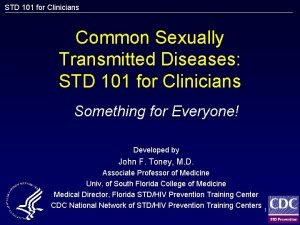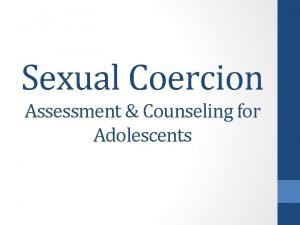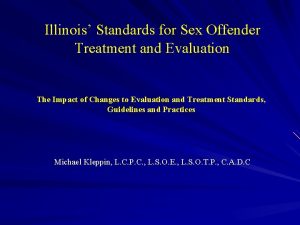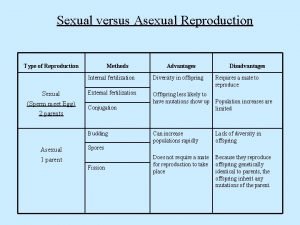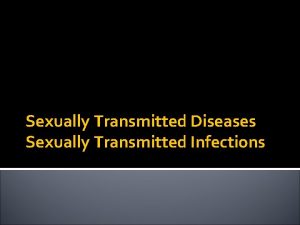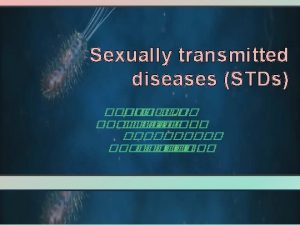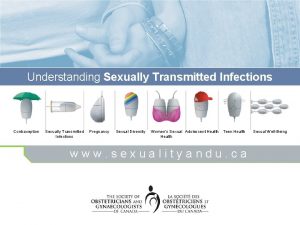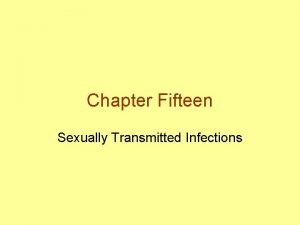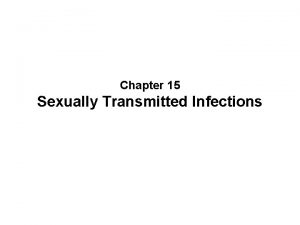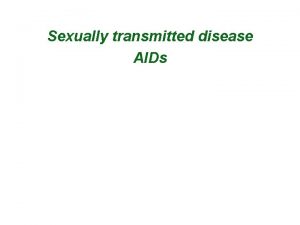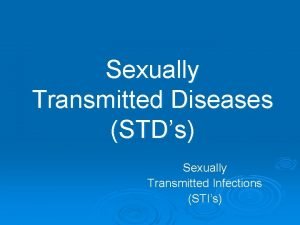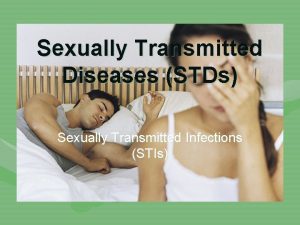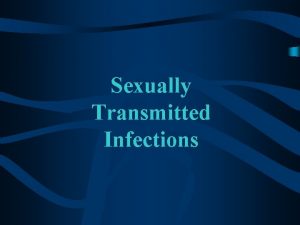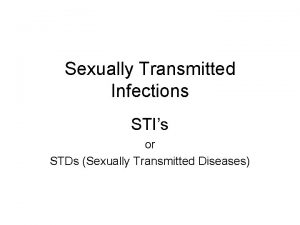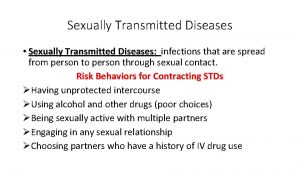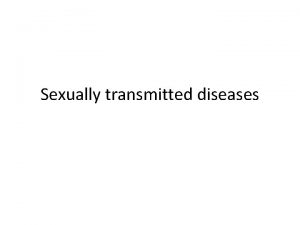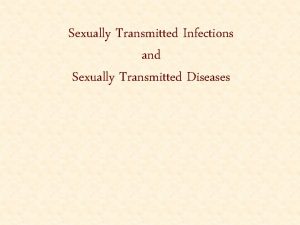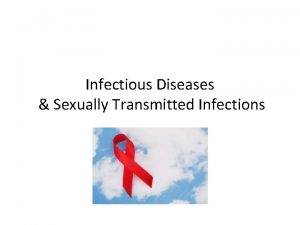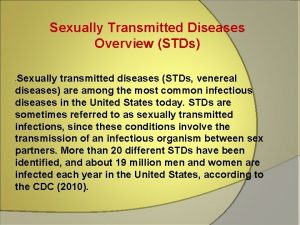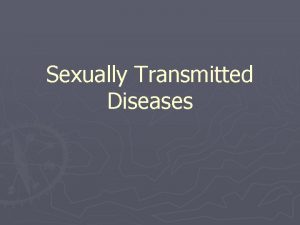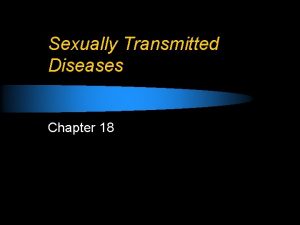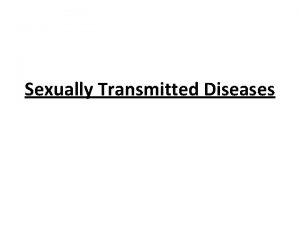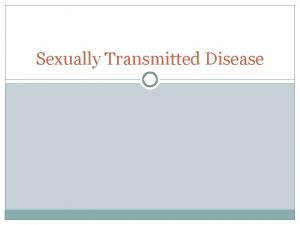April 4 th 2006 Sexually Transmitted Infections What












































- Slides: 44

April 4 th, 2006 Sexually Transmitted Infections What have YOU caught lately? Natalie Mulling Vanessa Sooknanan Lisa Elson Daneen Bianchi Maya George

STIs • Group # 4 • Chapter #29 • Sexually Transmitted Diseases/ Infections • Lesson #1 • Topic: Knowledge and Prevention

Audience Background • College Level: 1 st through 4 th

STI Video

Introduction • Sexually transmitted infections are most commonly broken into three main categories: – Bacterial STIs, viral STIs and parasitic STIs. – Among the most common bacterial STIs are chlamydia (also the most frequently found STI on college campuses), gonorrhea, pelvic inflammatory disease (PID) and syphilis.

– The most commonly seen viral STIs are herpes, genital warts (HPV), hepatitis B and HIV/AIDS, while trichomoniasis is the most frequent parasite. – All types of infections can occur whether one engages in heterosexual or homosexual behavior.

Sexually Transmitted Infection • Types of STIs – Chlamydia – Genital Herpes – Trichomoniasis – Human Papilloma Virus – Gonorrhea – Syphilis

Chlamydia • Chlamydia is the most frequently reported bacterial sexually transmitted infection. • Chlamydia is known as a “silent” disease because about ¾ of infected women and ½ of infected men have no symptoms.

Chlamydia — Rates by state: United States and outlying areas, 2004 Note: The total rate of chlamydia for the United States and outlying areas (Guam, Puerto Rico and Virgin Islands) was 316. 7 per 100, 000 population.

Chlamydia • Contraction – Transmitted during vaginal, anal, or oral sex. • Symptoms – Usually no signs or symptoms – Low back pain – Nausea, fever, pain during intercourse – Discharge from the genitals – Burning sensation when urinating

Chlamydia • Complication – cause Pelvic Inflammatory Disease (PID). – Chronic pelvic pain and infertility. – Complication for men are rare • Treatment – Easily treated and cured with antibiotics – Single dose of azithromycin or a week of doxycycline (2 x daily).

Chlamydia • Prevention – Abstain from sexual conduct – Latex male condoms – Annual screening test

Genital Herpes • Caused by Herpes Simplex virus type 1 and 2 • Nationwide, at least 45 million people ages 12 and older (1 out of every 5) have had a genital HSV infection.

Primary herpes, female

Primary herpes, male

Genital Herpes • Contraction – Sexual contact with someone who has HSV-2 – Can occur from a partner who has no visible sore • Symptoms – Most people infected with HSV-2 are not aware of it – Sores, flu-like symptoms

Genital Herpes • Complications – Recurrent painful genital sores – Psychological distress – Fatal infections in babies • Treatments – No treatment that can cure herpes • Antiviral medication can shorten and prevent outbreaks

Genital Herpes • Prevention – Abstain from sexual contact – Infection can still occur when infected site is covered by latex condom – Even correct and consistent use of latex condoms cannot guarantee protection from genital herpes

Trichomoniasis • The most common curable STI in young, sexually active women • Estimate of 7. 4 million new cases among men and women • Caused by single cell protozoan

Trichomoniasis • Contraction – Penis to vagina intercourse – Vulva to vulva (genital area outside the vagina) – Women can acquire the disease from infected man or women, but men usually contract it only from infected women • Symptoms – Most have no signs or symptoms – Irritation and itching of genital

Trichomoniasis • Complications – Genital inflammation • Treatments – Cured by prescription drug

Trichomoniasis • Prevention – Abstain from sexual contact – Latex male condoms

Human Papilloma Virus • Approximately 20 million people are currently infected with HPV • At least 50% of sexually active men and women will have had HPV • About 6. 2 million Americans get a new HPV infection each year

Condyloma acuminata, penile

Human Papilloma Virus • Contraction – Spread primarily through genital contact • Symptoms – Most have no signs or symptoms – Genital warts

Human Papilloma Virus • Complications – Can lead to cervical cancer (in rare cases) • Treatment – No ‘cure’ for HPV – In women it usually goes away on its own – Pap test usually comes back abnormal if you have HPV – No HPV test for men

Human Papilloma Virus • Prevention – Abstain from sexual contact – Infection can still occur when infected site is covered by latex condom – Even correct and consistent use of latex condoms cannot guarantee protection from HPV

Gonorrhea • Cause by the bacterium – Neisseria Gonorrhoeae • More than 700, 000 people in US get new infections each year • Only half the cases are reported

Gonococcal urethritis

Gonorrhea • Contraction – Spread through contact with the penis, vagina, mouth or anus – Ejaculation does not have to occur for it to be transmitted • Symptoms – Some have no symptoms at all – Burning sensation when urinating – White, yellow, or green discharge – Bladder or vaginal infection

Gonorrhea • Complications – Pelvic inflammatory disease (PID) – Can spread to blood and joints • Treatment – Several antibiotics can • cure gonorrhea • Some have drugresistant stains

Gonorrhea • Prevention – Abstain from sexual contact – Latex condoms • When used consistently and correctly

Syphilis • Cause by bacterium – Treponema pallidum • Between 2001 and 2002, cases increased 12. 5% • Infections are highest among – Women: 20 -24 years old – Men: 35 - 39 years old

Syphilis - Treponema pallidum

Syphilis • Contraction – Through direct contact from a syphilis sore • Symptoms – Primary stage • Single sore called chancre – Secondary stage • Skin rash and mucous membrane lesions – Last stage • Secondary symptoms disappear • Latent-no signs or symptoms

Primary syphilis - chancre

Secondary syphilis - papulopustular rash

Syphilis • Complications – Sore throat, fever, patchy hair loss, headaches, muscle aches – Damage to internal organs • Treatment – Easy to cure at early stages (less than 1 year) – Injection of penicillin – Will not reverse any damage already done

Syphilis • Prevention – Abstain from sexual contact – Talk to partner about being tested – Condoms lubricated with spermicide – Washing genitals, urinating, or douching after sex

Testing • Where you can get tested – – Planned Parenthood Alachua County Health Department UF Student Health Care Center Sante Fe Community College Health Center • How much does it cost? – Variable cost

Confidentiality • What are your rights? The patient has the right to be provided with appropriate privacy, including protection from access to their confidential information from the individuals who are not responsible for direct health care and by other staff working at the health care center.

Counseling Centers • Location – Alachua County Crisis Center – Shands Hospital – UF Counseling Center • Cost – Variable cost

Cultural Beliefs • Ethical and/ or moral beliefs • Potential limitations due to cultural beliefs pertaining to the prevention of sexually transmitted infections are: - Individuals are not allowed to use condom. - Shame associated with using a contraceptive

 Chapter 25 sexually transmitted infections and hiv/aids
Chapter 25 sexually transmitted infections and hiv/aids Chapter 24 sexually transmitted diseases and hiv/aids
Chapter 24 sexually transmitted diseases and hiv/aids Std
Std Nursing management of reproductive tract infection
Nursing management of reproductive tract infection Chapter 24 lesson 1 sexually transmitted diseases
Chapter 24 lesson 1 sexually transmitted diseases Sexually transmitted disease
Sexually transmitted disease Paula hurlock birthday
Paula hurlock birthday School calendar 2005-2006
School calendar 2005-2006 Genital infections
Genital infections Can methotrexate cause yeast infections
Can methotrexate cause yeast infections Storch infections
Storch infections Bacterial vaginosis
Bacterial vaginosis Genital infections
Genital infections Opportunistic infections
Opportunistic infections Bone and joint infections
Bone and joint infections Postpartum infections
Postpartum infections Phagocytr
Phagocytr Understanding the mirai botnet
Understanding the mirai botnet Retroviruses and opportunistic infections
Retroviruses and opportunistic infections Opportunistic infections
Opportunistic infections Acute gingival infections
Acute gingival infections Storch infections
Storch infections Neurosiphyllis
Neurosiphyllis How do birds have sexually reproduce
How do birds have sexually reproduce How do annelids reproduce
How do annelids reproduce Whale phylum
Whale phylum Radial symmetry
Radial symmetry What is sexual coersion
What is sexual coersion Parts of a sea cucumber
Parts of a sea cucumber Dimorphism meaning
Dimorphism meaning Sexual harassment training quiz
Sexual harassment training quiz Asexual reproduction of flatworm
Asexual reproduction of flatworm Cargo
Cargo Reproduction
Reproduction Is phytoplankton a protist
Is phytoplankton a protist Licensed sex offender treatment provider illinois
Licensed sex offender treatment provider illinois Example of a sexual propagation
Example of a sexual propagation Parasitism phylum
Parasitism phylum Spongocoel
Spongocoel Sexual abuse awareness training quiz answers
Sexual abuse awareness training quiz answers Male sexual response
Male sexual response Class aves
Class aves What is sexually dimorphic mean
What is sexually dimorphic mean A song transmitted orally which tell a story
A song transmitted orally which tell a story The totality of learned socially transmitted behavior
The totality of learned socially transmitted behavior





